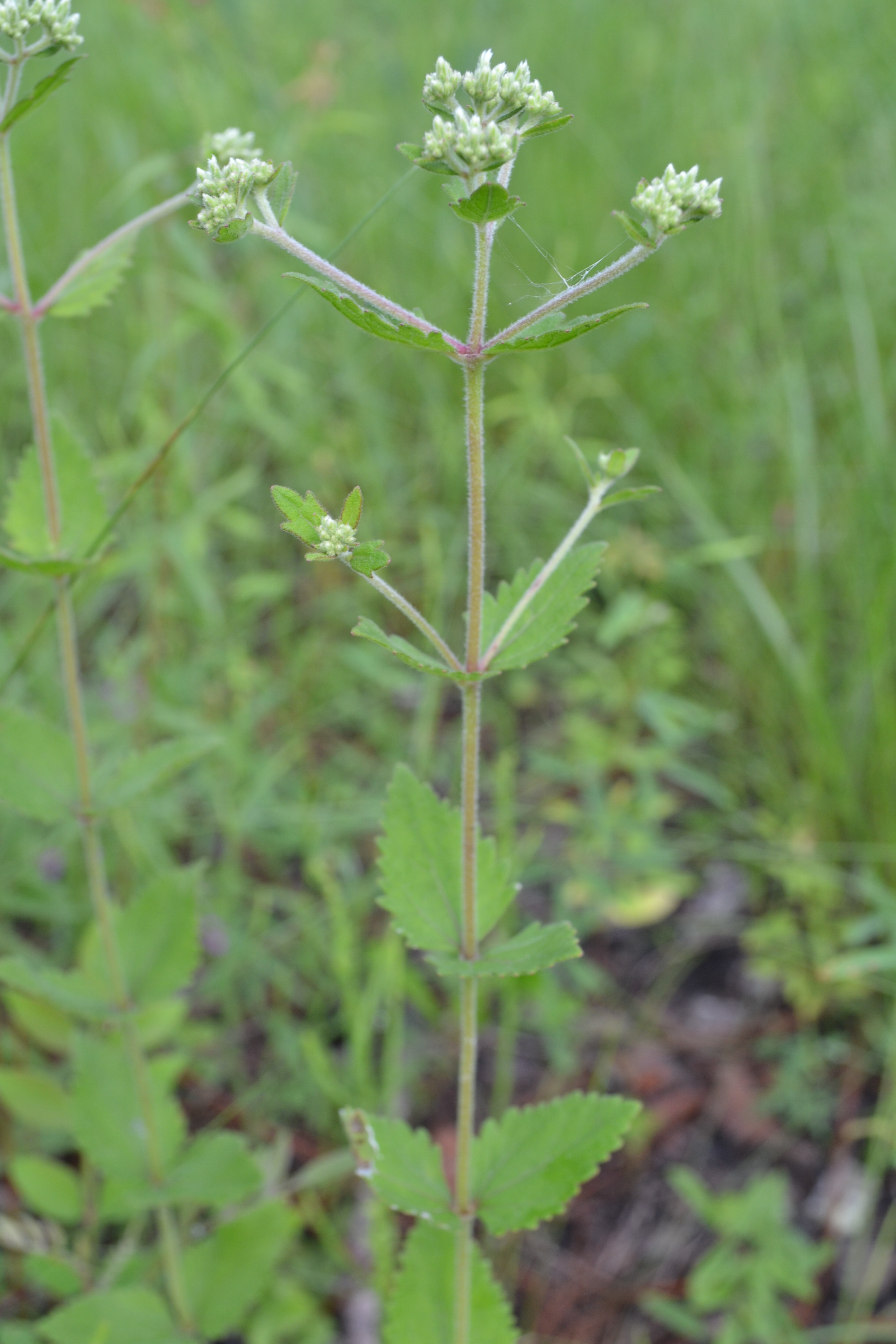Difference between revisions of "Eupatorium rotundifolium"
(→Ecology) |
|||
| Line 38: | Line 38: | ||
===Phenology=== <!--Timing off flowering, fruiting, seed dispersal, and environmental triggers. Cite PanFlora website if appropriate: http://www.gilnelson.com/PanFlora/ --> | ===Phenology=== <!--Timing off flowering, fruiting, seed dispersal, and environmental triggers. Cite PanFlora website if appropriate: http://www.gilnelson.com/PanFlora/ --> | ||
It has been observed flowering and fruiting from July to November (FSU Herbarium). | It has been observed flowering and fruiting from July to November (FSU Herbarium). | ||
| + | ===Seed dispersal=== | ||
| + | According to Kay Kirkman, a plant ecologist, this species disperses by wind. <ref name="KK"> Kay Kirkman, unpublished data, 2015. </ref> | ||
| + | ===Seed bank and germination=== | ||
| − | |||
| − | |||
===Fire ecology=== <!--Fire tolerance, fire dependence, adaptive fire responses--> | ===Fire ecology=== <!--Fire tolerance, fire dependence, adaptive fire responses--> | ||
It is fire-tolerant.<ref name="Brewer and Cralle 2003">Brewer, J. S. and S. P. Cralle (2003). "Phosphorus addition reduces invasion of a longleaf pine savanna (southeastern USA) by a non-indigenous grass (Imperata cylindrica)." Plant Ecology 167: 237-245.</ref> | It is fire-tolerant.<ref name="Brewer and Cralle 2003">Brewer, J. S. and S. P. Cralle (2003). "Phosphorus addition reduces invasion of a longleaf pine savanna (southeastern USA) by a non-indigenous grass (Imperata cylindrica)." Plant Ecology 167: 237-245.</ref> | ||
Revision as of 10:10, 14 April 2016
| Eupatorium rotundifolium | |
|---|---|

| |
| Photo was taken by Kevin Robertson | |
| Scientific classification | |
| Kingdom: | Plantae |
| Division: | Magnoliophyta - Flowering plants |
| Class: | Magnoliopsida – Dicotyledons |
| Order: | Asterales |
| Family: | Asteraceae ⁄ Compositae |
| Genus: | Eupatorium |
| Species: | E. rotundifolium |
| Binomial name | |
| Eupatorium rotundifolium L. | |

| |
| Natural range of Eupatorium rotundifolium from USDA NRCS Plants Database. | |
Common name: Roundleaf thoroughwort
Contents
Taxonomic notes
Synonyms: Eupatorium rotundifolium var. rotundifolium; E. rotundifolium Linnaeus ssp. rotundifolium
Description
A description of Eupatorium rotundifolium is provided in The Flora of North America.
Distribution
Ecology
It has well-documented anticancer activities against various human cancer cell lines.[1]
Habitat
It is found i river bottoms, creek bluffs, slash pine-palmetto flatwoods, near streams, in open-dry habitats, mixed woodlands, savannas, marshy areas, bottomland woodlands, edges of thickets, edges of titi swamps, open boggy areas, Longleaf pine-wiregrass savannas, and well-drained uplands (FSU Herbarium). It is also found in human disturbed areas such as pinelands that have been clear cut and plowed, roadside edges and ditches, in a drainage ditch, in roadside thickets, powerline corridors, in plowed pastures, and in fire breaks bordering pine flatwoods (FSU Herbarium).
It can be found in areas regularly burned every 1 to 2 years in the winter. It can be found in longleaf pine savanna communities.[2]
Associated species include Pinus taeda, P. palutris, P. elliottii, Serenoa repens, Taxodium distichum, Liquidambar styraciflua, Sabatia, Lilium, Eupatorium pilosum, E. semiserratum, E. recurvans, E. leucolepis, E. compositifolium, Ceanothus microphyllus, Ctenium, Rhus, Rubus, Aster spinulosus, Myrica cerifera, Magnolia virginiana, Aristida stricta, Cyrilla racemiflora (FSU Herbarium).
Phenology
It has been observed flowering and fruiting from July to November (FSU Herbarium).
Seed dispersal
According to Kay Kirkman, a plant ecologist, this species disperses by wind. [3]
Seed bank and germination
Fire ecology
It is fire-tolerant.[2]
Conservation and Management
Cultivation and restoration
Photo Gallery
References and notes
Florida State University Robert K. Godfrey Herbarium database. URL: http://herbarium.bio.fsu.edu. Last accessed: June 2014. Collectors: R.K. Godfrey, Jean Wooten, Victoria Sullivan, Delzie Demaree, Ed Keppner, Lisa Keppner, Clarke Hudson, Carol Havlik, Loran C. Anderson, Nancy E. Jordan, J. P. Gillespie, J. Wooten, J. Lazor, R.L. Lazor, Gwynn W. Ramsey, Richard S. Mitchell, A. F. Clewell, K. Craddock Burks, R. Kral, P. L. Redfearn, Jr., Olga Lakela, Kurt Blum, Doug Gae, R. A. Norris, and Cecil R Slaughter. States and Counties: Arkansas: Lafayette and Sevier. Florida: Alachua, Bay, Calhoun, Citrus, Columbia, Duval, Escambia, Franklin, Gadsden, Gilchrist, Gulf, Hernando, Highlands, Hillsborough, Holmes, Jackson, Jefferson, Lake, Lee, Leon, Levy, Liberty, Madison, Nassau, Okaloosa, Okeechobee, Orange, Osceola, Pasco, Polk, Putnam, Santa Rosa, Sarasota, St. John’s, Suwannee, Taylor, Union, Wakulla, and Washington. Georgia: Grady and Thomas. South Carolina: Jasper.
- ↑ Kintzios, S. E. (2007). "Terrestrial plant-derived anticancer agents and plant species used in anticancer research." Critical Reviews in Plant Sciences 25: 79-113.
- ↑ 2.0 2.1 Brewer, J. S. and S. P. Cralle (2003). "Phosphorus addition reduces invasion of a longleaf pine savanna (southeastern USA) by a non-indigenous grass (Imperata cylindrica)." Plant Ecology 167: 237-245.
- ↑ Kay Kirkman, unpublished data, 2015.